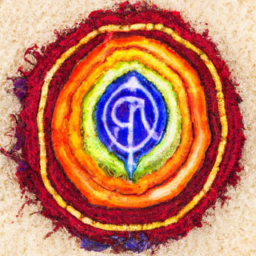Exploring the Power of Root Chakra in Sanskrit
The concept of chakras plays a significant role in many Eastern spiritual traditions. Chakras, meaning “wheels” in Sanskrit, are believed to be energy centers located in the subtle body that are responsible for the physical, emotional, and spiritual well-being of an individual. The root chakra, also known as the Muladhara chakra, is the first of the seven chakras and is often considered the foundation of our entire chakra system.
Derived from the Sanskrit word “mula”, meaning “root”, and “adhar”, meaning “support”, the root chakra is associated with the element of earth and is located at the base of the spine. It is represented by a red lotus with four petals, and its symbol resembles a downward-pointing triangle with a red square inside it. Just like the color red, the root chakra is all about vitality, strength, and stability.
In Sanskrit, the root chakra is referred to as the “Muladhara”, which translates to “root support” or “root foundation”. This name signifies the significance of this chakra as it is responsible for providing a strong and stable foundation for our physical, emotional, and spiritual well-being.
The root chakra is believed to be the gateway to our physical self and is associated with basic human survival instincts, such as shelter, food, water, and safety. It also governs our sense of stability, security, and grounding. A balanced root chakra can help us feel connected to the present moment and the physical world around us, while an imbalanced root chakra can lead to feelings of fear, anxiety, and insecurity.
There are various mantras, or sacred words or phrases, associated with each chakra, and the root chakra is no exception. The mantra for the root chakra is ”Lam”, which is believed to stimulate the energy flow in this chakra and help balance it. Chanting “Lam” can help release any blockages in the root chakra and promote feelings of stability and security.
Another important aspect of the root chakra in Sanskrit is its associated deity, Goddess Dakini. She is often depicted as a fierce and powerful female figure, representing the primal energy of the root chakra. She is believed to be a symbol of transformation and courage, guiding us on the path of self-discovery and grounding us in the present moment.
It is essential to keep the root chakra in balance to lead a healthy and fulfilling life. There are several practices, such as yoga, meditation, and pranayama, or breathing techniques, that can help stimulate and balance the root chakra. Some yoga poses that target the root chakra include Tadasana (Mountain pose), Malasana (Garland pose), and Virabhadrasana (Warrior I pose).
In addition to these practices, incorporating grounding activities into your daily routine can also help balance the root chakra. Walking barefoot on the grass, connecting with nature, and eating root vegetables are some simple yet powerful ways to ground yourself and connect with the energy of the earth.
The root chakra in Sanskrit is a powerful and essential energy center that influences the physical, emotional, and spiritual aspects of our being. By understanding its significance and incorporating practices that promote its balance, we can cultivate a strong foundation and lead a more grounded and fulfilling life. Let us embrace the power of “Muladhara” and connect with our primal energy to unlock our true potential.





This is so interesting!
Karen24:Thank you for posting! #knowledge
Great post! This is a fascinating look into the power of the Root Chakra, and the power of Sanskrit in unlocking its true potential. #RootChakra #Sanskrit
Interesting and informative! #RootChakra #Sanskrit